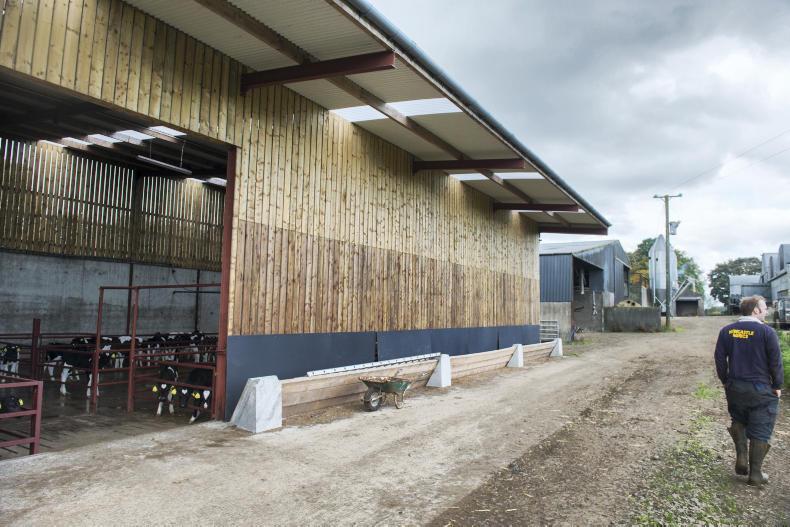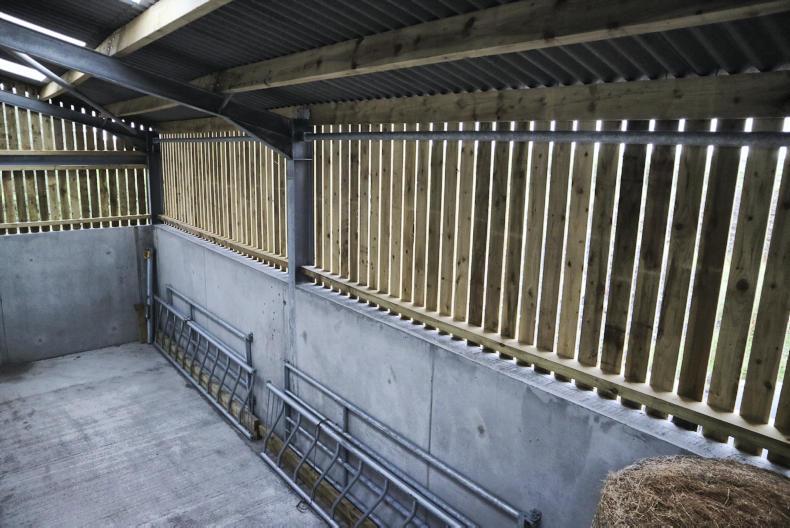The Irish Farmers Journal specialist team will be examining every aspect of a calf’s life from birth until weaning on the day, including taking a closer look at calf housing and the pitfalls that exist.
We will start by looking at what the calf needs, including a warm dry area, with fresh air at nose level in an independent space away from other groups of stock.
Investment
For many farmers who have expanded over the past few years and invested heavily in both cubicle houses and milking parlours, the next area that is in need of investment is calf housing.
Talks will run throughout the day focusing on improving ventilation in your current shed and what to be conscious of if building a new shed, with our very own shed in place on the day.
Over the past year, more and more farmers have turned towards using spaced boarding or Yorkshire boarding on their sheds to improve airflow, which will in turn reduce the disease pressure on animals.
The options
The most common type of inlet ventilation on Irish farms currently is vented sheeting. However, not all vented sheeting is created equal, with the void space varying from 5% up to 18% in some cases.
We will examine the use of spaced boarding as a way of improving airflow while still protecting calves from draughts.
Spaced boarding involves having 100mm boards with a 25mm gap to provide a void area of 20%.

A recent calf shed that was built using spaced boarding on both sides of the shed.
Yorkshire boarding may be needed in more exposed sites. It involves having two rows of boards placed offset on either side of the purloins. This way the inside board will shelter the gap left between the outside boards. 
This type of boarding should be used more commonly for calf sheds.
It is particularly useful for calf housing if the prevailing wind is getting through spaced boarding, causing bedding to become damp.
We will examine the costs associated with each type of inlet ventilation, while also looking at the life expectancy of timber cladding on the side of buildings and what maintenance may be required over this time.

Yorkshire boarding that was installed on one side of Greenmount's new sheep shed as this side was very exposed to the rain.
The aim with using timber cladding would be to have a void area of 20%.
When we compare this to some vented sheeting that has a void area of 5%, there could be a major difference on air movement in the shed. We will have different examples of each type of cladding on the day so farmers can see for themselves the difference that exists.
Read more
The A to K of companies farmers can talk to at Dairy Day
The L to Z of companies farmers can meet at Dairy Day
Weekly vet view: unlocking the potential of fresh air
The Irish Farmers Journal specialist team will be examining every aspect of a calf’s life from birth until weaning on the day, including taking a closer look at calf housing and the pitfalls that exist.
We will start by looking at what the calf needs, including a warm dry area, with fresh air at nose level in an independent space away from other groups of stock.
Investment
For many farmers who have expanded over the past few years and invested heavily in both cubicle houses and milking parlours, the next area that is in need of investment is calf housing.
Talks will run throughout the day focusing on improving ventilation in your current shed and what to be conscious of if building a new shed, with our very own shed in place on the day.
Over the past year, more and more farmers have turned towards using spaced boarding or Yorkshire boarding on their sheds to improve airflow, which will in turn reduce the disease pressure on animals.
The options
The most common type of inlet ventilation on Irish farms currently is vented sheeting. However, not all vented sheeting is created equal, with the void space varying from 5% up to 18% in some cases.
We will examine the use of spaced boarding as a way of improving airflow while still protecting calves from draughts.
Spaced boarding involves having 100mm boards with a 25mm gap to provide a void area of 20%.

A recent calf shed that was built using spaced boarding on both sides of the shed.
Yorkshire boarding may be needed in more exposed sites. It involves having two rows of boards placed offset on either side of the purloins. This way the inside board will shelter the gap left between the outside boards. 
This type of boarding should be used more commonly for calf sheds.
It is particularly useful for calf housing if the prevailing wind is getting through spaced boarding, causing bedding to become damp.
We will examine the costs associated with each type of inlet ventilation, while also looking at the life expectancy of timber cladding on the side of buildings and what maintenance may be required over this time.

Yorkshire boarding that was installed on one side of Greenmount's new sheep shed as this side was very exposed to the rain.
The aim with using timber cladding would be to have a void area of 20%.
When we compare this to some vented sheeting that has a void area of 5%, there could be a major difference on air movement in the shed. We will have different examples of each type of cladding on the day so farmers can see for themselves the difference that exists.
Read more
The A to K of companies farmers can talk to at Dairy Day
The L to Z of companies farmers can meet at Dairy Day
Weekly vet view: unlocking the potential of fresh air










 This is a subscriber-only article
This is a subscriber-only article













SHARING OPTIONS: